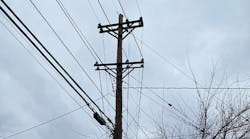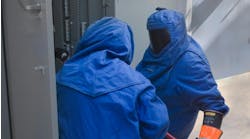Note: This article does not represent final determinations regarding the nature of the incident, cause of the injury, or fault of employer, employee, or any party involved.
When a married man with a young daughter left for work one early autumn morning, his family, friends, and coworkers could not have foreseen the tragic events that would soon unfold. On that fateful day, the 31-year-old employee of an engineering firm was tasked with surveying utility pole placement in support of the development of engineering plans. During the course of his duties, the field technician, who had been with the company for two years and three months, discovered a downed power line. The victim attempted to move the power line but found it was tangled in a nearby tree. As he worked to unravel the power line, it somehow became energized and electrocuted him as he held the wire.
Setting the stage
The decedent’s employer was an engineering firm founded in 2014 that employs 22 people. The company, which operates in multiple states across the U.S., specializes in surveying, analyzing, and mapping of utility poles.
According to a company representative, employees receive CPR training, first aid training, OSHA 10-hour training, online electrical safety training, and traffic safety training. The representative for the engineering firm also said it issues each employee a company safety manual but declined to provide specifics on the content of the manual.
The scene
On Nov. 4, 2020, a two-person crew departed their out-of-state place of business en route to a large Kentucky metro area with the task of surveying power lines to develop future engineering plans. The job site was a residential area with homes located on each side of a two-lane highway (Photo 1).
Due to the placement of the utility poles and their proximity to the highway, the job required the duo to work in the front yards of private residences. Most of the overhead wires in this area run parallel with the roadway and cross over the highway at several points with smaller wires branching off to other parts of the area.
On this unseasonably warm November day — 68°F, 39% humidity, 8 mph winds, and no precipitation — the employees worked their way from utility pole to utility pole, collecting data such as pole height, distance between poles, and each pole’s proximity to the highway. The data they collected would later be used to develop engineering plans for the installation of fiber-optic cable.
During the course of their tasks, the crew encountered a downed power line, which investigators determined was likely caused by a recent windstorm that had occurred in the area (Photo 2).
According to a company representative, the downed power line was entangled in a nearby tree that sat approximately 8 ft from the utility pole. The company representative stated that after the victim located the downed line, he worked to free it from the tree. Although the line was not initially energized, at some point in the process of untangling the wire, it became energized and delivered an electric shock to the victim, killing him instantly. As the victim maintained contact with the wire, his clothing caught fire, and his body was burned. The official cause of death was determined to be high-voltage electrocution (Photo 3).
Contributing factors
Kentucky FACE investigators identified the following unrecognized hazards as key contributing factors in this incident:
- Lack of hazard awareness.
- Insufficient procedures.
- Lack of training.
FACE Recommendations
In an effort to prevent a similar incident like this from occurring again, FACE offers three recommendations.
Recommendation 1: Employers should consider development of policies and procedures that specify the standard operating procedures for employees who encounter a downed power line.
According to the company, the victim had completed an online electric safety course, hosted by a third party upon being hired, two years and three months earlier. In this case, the victim had broad-spectrum training of general electrical safety, which was taken online. An example of a policy that may have prevented this particular fatality could simply read, “Downed power lines are dangerous; always assume a downed line is energized. If a downed line is located or observed, do not approach or touch the line. Leave the area immediately and contact a supervisor to report.” The policy should identify the hazard, the steps that should be taken to minimize or avoid the hazard, and clearly identify the expectation of what is expected of the employee if the situation arises. In addition, OSHA provides “rules to live by” when dealing with a downed electrical line:
- Do not assume a downed power line is safe because it is on the ground or it is not sparking.
- Do not assume that any wire is a harmless telephone, television, or fiber-optic cable, and does not carry lethal current.
- Treat everything electrical as energized until tested and proven to be de-energized.
- Never go near a downed or fallen electric power line.
- Electricity can spread outward through the ground in a circular shape from the point of contact. As you move away from the center, large differences in voltages can be created.
- Never drive over downed power lines. Assume they are energized.
- If contact is made with an energized power line while you are in a vehicle, do not exit the vehicle unless it is on fire. If possible, call for help.
- If you must exit any equipment because of fire or other safety reasons, try to jump completely clear, making sure that you do not touch the equipment and the ground at the same time. Land with both feet together and shuffle away in small steps to minimize the path of electric current and avoid electric shock. Be careful to maintain your balance.
To help avoid similar events, employers should develop standard operating procedures that specify what actions employees are to take when a downed power line is encountered and restrict employees from engaging in activities for which they are not adequately trained to complete.
Recommendation 2: Employers should perform a job hazard analysis.
Prior to the employees arriving on scene, the company had no knowledge of a downed power line in the area in which the employees were required to work. The lack of awareness presented the employees with an unexpected hazard that they were unprepared to address appropriately and safely. Implementing a job hazard analysis process can help employers identify safety hazards that may be present and unique to a particular worksite prior to performing a job. OSHA defines a Job Hazard Analysis (JHA) as “a technique that focuses on job task as a way to identify hazards before they occur. It focuses on the relationship between the worker, the task, the tools, and the work environment.” A properly executed JHA of the worksite would have exposed known hazards and hazards that are likely or could be present in the future.
Furthermore, it is probable that a company employee whose primary function is to survey utility poles may observe or encounter a downed power line at some point throughout the course of his or her duties. A JHA would allow the company to analyze these risks, proactively develop a procedure for addressing the risk of a downed power line, ensure employees have the proper personal protective equipment, and allow for adequate training of employees prior to placing them in a risky environment. A JHA can be specific to a particular site, not just a task. Oftentimes, a new work site can expose a unique risk. Performing a JHA anytime employees are required to work in a new area or job site would likely have exposed the downed power line. After discovering the hazard, employers could have made the decision to eliminate the hazard by not allowing employees on the premises until the hazard was removed or allowed adequate time to develop a plan to complete the task in a safe manner.
A JHA may also reveal the need for additional policy and procedures. For example, calling the utility company prior to beginning work at a new site to check for reports of downed lines would be a logical procedure to implement, once the hazard had been identified in the JHA process. To ensure employee safety, employers should perform job hazard analysis on the task they require their employees to perform and prior to working at new locations that may have unknown hazards.
Recommendation 3: Employers should provide hazard awareness training to employees annually.
According to The National Fire Protection Association (NFPA), 1,651 workers died as a result of electrical injury between 2007 and 2016, which is nearly 3.5 deaths per week over a nine-year period. Electrocution often occurs rapidly and without warning, leaving the victim unable to act. Thus, proper hazard awareness training is critical for workers who could potentially be exposed to electric shock. Although the victim had received web-based electrical safety training through a third party upon being hired, electric shock hazard awareness training should occur on an annual basis. Hazard awareness training that is specific to the types of exposure the employee is likely to encounter should also be implemented. This training should include company-specific policies and procedures that have been developed and align with the expectations the company has for the employee’s response to electrical hazards. Each employee subject to being exposed to the hazard should receive training; the training should include a form of validation that the employees understand and should reoccur on an annual basis to combat complacency.
A hard lesson
Occupational injuries and fatalities are often the result of one or more contributing factors or key events in a larger sequence of events that ultimately result in the injury or fatality. As evidenced by this unnecessary tragedy, no one should ever make contact with a downed power line or any electrical wire, no matter how innocuous it may appear.
This case report was developed by the Kentucky Fatality Assessment and Control Evaluation (FACE) Program. Kentucky FACE is a National Institute for Occupational Safety and Health (NIOSH)-funded occupational fatality surveillance program with the goal of preventing fatal work injuries by studying the worker, the work environment, and the role of management, engineering, and behavioral changes in preventing future injuries. Kentucky FACE is funded by grant 5U6O0H008483-16 from NIOSH. For more information, visit https://kiprc.uky.edu.





